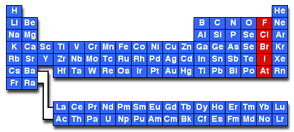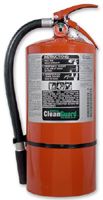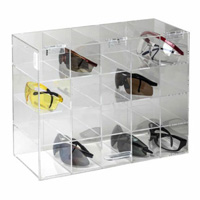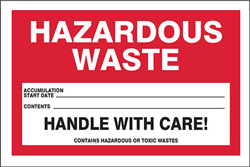



Find all of your laboratory and workplace safety supplies at Safety Emporium!
 Gingivitis |
 Glossary Index |
 Hazard Classification |
| MSDS Topics |
Free Sites | FAQ's | Regulations | Glossary | Software | Suppliers |
| Books | Forum | Poll | Fun stuff | Quiz | Store | |
| Understand your MSDS with the MS-Demystifier | Search ALL our MSDS info | |||||


Protect sensitive electronic and laboratory equipment with Ansul CleanGuard extinguishers from Safety Emporium.
The elemental forms of the halogens are all diatomic (two-atom) molecules e.g. F2 (gas), Cl2 (gas), Br2 (liquid), and I2 (volatile solid). Astatine is not naturally occurring (only a few micrograms have ever been produced) so we will ignore it here.
In their elemental forms, all of the halogens are toxic, strong oxidizers, and very chemically reactive. Fortunately, only laboratory chemists tend to encounter these in their elemental forms.
Two broad classes of halogenated materials are:
Some other terms that involve halogens are halocarbon (a halogenated hydrocarbon), chlorocarbon (a chlorinated hydrocarbon) and chlorofluorocarbon (CFC, a class of molecules containing Cl, F, and C that are useful refrigerants and extinguishing agents, but are also very bad for the ozone layer). You may also hear the term halogenated waste around the laboratory, because chemists often segregate their chemical wastes into halogenated materials and non-halogenated materials because it costs more to dispose of halogenated materials and because halogenated wastes are sometimes incompatible with other wastes.
Halogenated organic molecules are a very important class of chemicals that are used to produce a wide variety of other chemicals and consumer products. Unfortunately, chlorinated organic molecules are often health hazards and some are even known human carcinogens. Therefore, if you are working with a chlorinated material, you should pay particular attention to the SDS and other available health information.
A good rule of thumb is that the more chlorine atoms an organic molecule has, the more likely it is to be carcinogenic. Some examples of chlorinated molecules that are thought to pose health hazards include the following:


Make your PPE readily available with safety dispensers from Safety Emporium.
NOTE: We may collect a share of sales or other compensation from the links in the following list:
Always read the Safety Data Sheet for any material, but take particular care to read it for a chlorinated organic material. You can minimize your exposure to chlorinated organics by 1) reducing or eliminating their use, 2) using them only with proper engineering controls such as local exhaust ventilation or a fume hood and 3) using proper personal protective equipment (PPE) such as an organic vapor respirator (a paper mask does NOTHING), goggles, non-permeable gloves and an chemically-resistant apron. Also remember that many such materials are flammable.
Inorganic halides and ionic halides can pose varying degrees of risk. For example, titanium tetrachloride (TiCl4) reacts violently with moisture in the air to form dense clouds of HCl (an acid) gas. Even sodium chloride can pose hazards - NaCl reacts with sulfuric acid to give HCl(g) as a product. And you always wondered why table salt needs an SDS.
Two recent literature reports of significant injuries caused by injection of methylene chloride (dichloromethane) can be found in our necrosis entry. In neither case did the SDS address injection as a route of exposure. These cases underscore why it is critical to always maintain proper chemical hygiene practices regardless of what the SDS says (or doesn't say) in Section 11 (toxicological information). Remember, HCS 2012 does not require testing if there is no data; chemicals are presumed innocent until proven guilty.

Get your hazardous waste labels from Safety Emporium.
See also: carbon tetrachloride, organic, solvent.
Additional definitions from Google and OneLook.
Entry last updated: Saturday, December 31, 2022. This page is copyright 2000-2025 by ILPI. Unauthorized duplication or posting on other web sites is expressly prohibited. Send suggestions, comments, and new entry desires (include the URL if applicable) to us by email.
Disclaimer: The information contained herein is believed to be true and accurate, however ILPI makes no guarantees concerning the veracity of any statement. Use of any information on this page is at the reader's own risk. ILPI strongly encourages the reader to consult the appropriate local, state and federal agencies concerning the matters discussed herein.